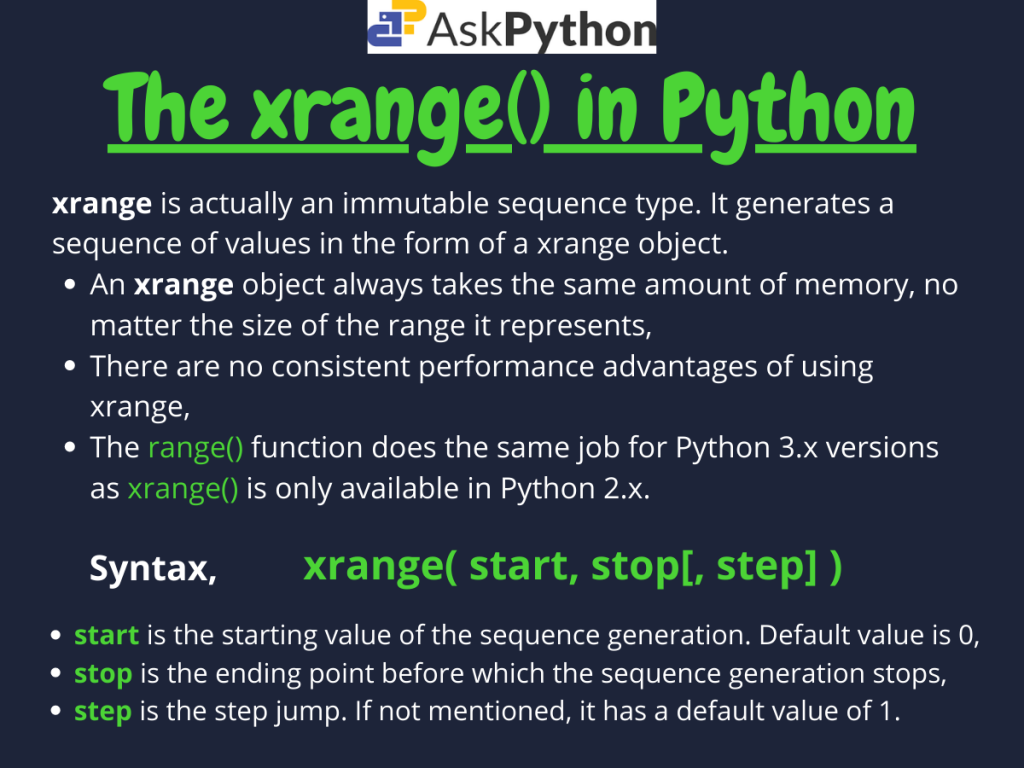Today in this tutorial, we are going to discuss the Python xrange() method.
The xrange() method is only available for use in Python 2.x versions and used in loops for traversing or iterating through the sequence.
Basics of the Python xrange() Method
The Python xrange() method returns a xrange type object which is an immutable sequence commonly used for looping. These objects have very little behavior and only support indexing, iteration, and the len() function.
xrange(start, stop[, step])
Here:
- start(optional) is the starting point from which the sequence generation would start. It is included in the sequence and if not mentioned is by default set to 0,
- stop is the number before which the sequence generation would stop(exclusive),
- step(optional) is the step jump the function would to take while sequence generation or iteration. By default, it has a value of 1.
Using the Python xrange() Method
Now let us look at the various ways we can actually use the Python xrange() method.
1. With only stop parameter
The two parameters, step and start are optional as they have default values of 1 and 0 respectively. Hence we can use the Python xrange() method just by specifying the stop parameter.
When only stop is mentioned, the xrange() function creates a sequence ranging from 0 to (stop-1) with step 1. Look at the example below.
# xrange() with only stop parameter
x = xrange(4)
print "Type of returned object = ", type(x)
print "Sequence generated by xrange() 1 parameter: ", list(x)
Output:
Type of returned object = <type 'xrange'>
Sequence generated by xrange() 1 parameter: [0, 1, 2, 3]
Here, the type of sequence generated by the method is of type xrange as mentioned earlier. Type-casting the xrange() output into a list gives us a list containing the values 0 to 3(4-1) with step 1.
2. With start and stop parameters
Similarly, we can also use the Python xrange() method with two parameters. In this case by default, the step has a value 1.
# xrange() with start & stop parameters
x = xrange(2, 9)
print "Type of returned object = ", type(x)
print "Sequence generated by xrange() 2 parameters: ", list(x)
Output:
Type of returned object = <type 'xrange'>
Sequence generated by xrange() 2 parameters: [2, 3, 4, 5, 6, 7, 8]
As we can see from the above output, the Python xrange object this time contains values ranging from 2(start) to 8(stop-1) with a default step 1.
3. With all start, stop, and stop values
When all the parameters are mentioned, the Python xrange() function gives us a xrange object with values ranging from start to stop-1 as it did in the previous case. But this time, the jump from one element to another is equal to the step passed.
Have a look at the example below carefully. Here we have considered step as 5, start=5 and, stop=40.
# xrange() with 3 parameters
x = xrange(5, 40, 5) #positive step
y = xrange(9, 1, -1) #negative step
print "Sequences generated for 3 parameters by xrange"
print "x : ", list(x)
print "y : ", list(y)
Output:
Sequences generated for 3 parameters by xrange
x : [5, 10, 15, 20, 25, 30, 35]
y : [9, 8, 7, 6, 5, 4, 3, 2]
From the output, it is clear that the sequence is generated with values in range 5 to 39(40-1). For the last element, since 40 exceeds the stop-1 mark it is not considered.
Using Python xrange() in loops
As we mentioned earlier, xrange() is widely used in for loop structures in Python 2. For example in the code below we try to print the table for the number 10.
# using xrange in loops
print "Table of 10: "
for i in xrange(10, 101, 10):
print i
Output:
Table of 10:
10
20
30
40
50
60
70
80
90
100
Here, we have mentioned start=10, stop=101 and step=10. Stop has been considered as 101 since we want the sequence to include the 100(100-1) element. As we can see we get all the multiples of 10 ranging from 10 to 100.
Hence, the output is justified.
Python xrange() vs range()
Normally, xrange() is only used when the user wants his/her code to be only designed for Python 2.x versions as it is not available for Python 3.x versions. For Python 3 the range() method replaces the xrange() method instead.
The major difference between the two function is that, both of them return different objects with different properties.
The xrange() method returns a xrange object which is an immutable sequence and which only supports iteration, indexing and len function as mentioned earlier.
On the other hand, the range() method returns a list which supports major functions like slicing, pop() etc.
# xrange() vs range()
x = xrange(1, 10)
y = range(1, 10)
print "Type(x) = ", type(x)
print "Type(y) = ", type(y)
Output:
Type(x) = <type 'xrange'>
Type(y) = <type 'list'>
Moreover, xrange objects are more useful when we need to build code with minimal space complexity as it takes fairly constant memory size independent of the range of values it stores.
If you want to write a program that can be run or executed on both Python 2 and 3, using the range() method makes more sense and hence is recommended.
Conclusion
So in this tutorial, we understood the working as well as use of the Python xrange() method.
For any further questions, feel free to ask them in the comments below.
References
- Python range() Method,
- What is the difference between range and xrange functions in Python 2.X? – StackOverflow Question.
